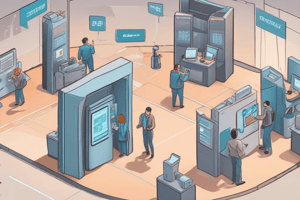Podcast
Questions and Answers
What is the primary purpose of access control?
What is the primary purpose of access control?
- To provide convenience to individuals
- To prevent unauthorized access and protect people, assets, and sensitive information (correct)
- To monitor and track employee productivity
- To enhance the physical appearance of a building
Which type of access control restricts access to physical spaces?
Which type of access control restricts access to physical spaces?
- Physical Access Control (correct)
- Discretionary Access Control
- Logical Access Control
- Role-Based Access Control
What is the process of verifying an individual's claimed identity?
What is the process of verifying an individual's claimed identity?
- Authentication (correct)
- Accountability
- Authorization
- Identification
Which access control model grants access based on a set of rules defined by the operating system or administrator?
Which access control model grants access based on a set of rules defined by the operating system or administrator?
What is the process of tracking and monitoring access to resources to ensure accountability and detect potential security breaches?
What is the process of tracking and monitoring access to resources to ensure accountability and detect potential security breaches?
Which type of access control restricts access to digital resources?
Which type of access control restricts access to digital resources?
What is the process of granting or denying access to a resource based on an individual's identity, role, or privileges?
What is the process of granting or denying access to a resource based on an individual's identity, role, or privileges?
Which access control model grants access based on an individual's role or job function within an organization?
Which access control model grants access based on an individual's role or job function within an organization?
What is the primary role of security officers in incident response?
What is the primary role of security officers in incident response?
What is the first phase of incident response?
What is the first phase of incident response?
What is a key consideration for effective incident response?
What is a key consideration for effective incident response?
What should incident response plans be?
What should incident response plans be?
What is the goal of the Eradication phase of incident response?
What is the goal of the Eradication phase of incident response?
What is a key aspect of the Post-Incident Activities phase?
What is a key aspect of the Post-Incident Activities phase?
What is critical for incident response?
What is critical for incident response?
What should incident response plans take into account?
What should incident response plans take into account?
Flashcards are hidden until you start studying
Study Notes
Security Officer: Access Control
Definition and Purpose
- Access control refers to the process of granting or denying individuals or vehicles access to a specific area, resource, or system.
- The primary purpose of access control is to prevent unauthorized access, protect people, assets, and sensitive information, and ensure the security and integrity of an organization.
Types of Access Control
- Physical Access Control: restricts access to physical spaces, such as buildings, rooms, or areas, using mechanisms like locks, doors, gates, and barriers.
- Logical Access Control: restricts access to digital resources, such as computer systems, networks, and data, using mechanisms like passwords, authentication, and authorization.
Access Control Measures
- Identification: verifying an individual's identity through credentials, such as ID cards, biometric data, or passwords.
- Authentication: verifying an individual's claimed identity through various methods, such as passwords, PINs, smart cards, or biometric scans.
- Authorization: granting or denying access to a resource based on an individual's identity, role, or privileges.
- Accountability: tracking and monitoring access to resources to ensure accountability and detect potential security breaches.
Access Control Models
- Discretionary Access Control (DAC): access is granted or denied based on the discretion of the owner or administrator.
- Mandatory Access Control (MAC): access is granted or denied based on a set of rules defined by the operating system or administrator.
- Role-Based Access Control (RBAC): access is granted or denied based on an individual's role or job function within an organization.
- Attribute-Based Access Control (ABAC): access is granted or denied based on a user's attributes, such as department, job function, or security clearance.
Best Practices for Security Officers
- Implement a layered access control system that includes multiple measures to prevent unauthorized access.
- Conduct regular security audits and risk assessments to identify vulnerabilities.
- Establish clear access control policies and procedures.
- Provide training and awareness programs for employees on access control measures.
- Continuously monitor and update access control systems to ensure they remain effective and up-to-date.
Access Control
- Access control is the process of granting or denying individuals or vehicles access to a specific area, resource, or system to prevent unauthorized access, protect people, assets, and sensitive information, and ensure the security and integrity of an organization.
Types of Access Control
- Physical access control restricts access to physical spaces, such as buildings, rooms, or areas, using mechanisms like locks, doors, gates, and barriers.
- Logical access control restricts access to digital resources, such as computer systems, networks, and data, using mechanisms like passwords, authentication, and authorization.
Access Control Measures
- Identification verifies an individual's identity through credentials, such as ID cards, biometric data, or passwords.
- Authentication verifies an individual's claimed identity through various methods, such as passwords, PINs, smart cards, or biometric scans.
- Authorization grants or denies access to a resource based on an individual's identity, role, or privileges.
- Accountability tracks and monitors access to resources to ensure accountability and detect potential security breaches.
Access Control Models
- Discretionary Access Control (DAC) grants or denies access based on the discretion of the owner or administrator.
- Mandatory Access Control (MAC) grants or denies access based on a set of rules defined by the operating system or administrator.
- Role-Based Access Control (RBAC) grants or denies access based on an individual's role or job function within an organization.
- Attribute-Based Access Control (ABAC) grants or denies access based on a user's attributes, such as department, job function, or security clearance.
Best Practices for Security Officers
- Implement a layered access control system that includes multiple measures to prevent unauthorized access.
- Conduct regular security audits and risk assessments to identify vulnerabilities.
- Establish clear access control policies and procedures.
- Provide training and awareness programs for employees on access control measures.
- Continuously monitor and update access control systems to ensure they remain effective and up-to-date.
Incident Response
Definition
- Incident response is the process of responding to and managing security incidents, such as data breaches, cyber-attacks, or physical intrusions.
Roles and Responsibilities
- Security officers are responsible for:
- Coordinating with other teams to respond to incidents
- Assessing incident scope and impact
- Containing and mitigating incident effects
- Conducting incident analysis and root cause identification
- Developing and implementing incident response plans and procedures
Incident Response Phases
Detection and Reporting
- Identifying and reporting security incidents
Initial Response
- Initial assessment and containment of the incident
Analysis and Containment
- In-depth analysis and containment of the incident
Eradication
- Removing the root cause of the incident
Recovery
- Restoring systems and data to a known good state
Post-Incident Activities
- Reviewing and documenting the incident
- Identifying lessons learned
- Implementing improvements
Key Considerations
- Incident response plans should:
- Be developed in advance
- Be tested and exercised regularly
- Be communicated to all stakeholders
- Be flexible and adaptable to different types of incidents
- Be reviewed and updated regularly
- Effective incident response requires:
- Clear communication and coordination among teams
- Timely and accurate incident reporting
- Proper incident analysis and root cause identification
- Effective containment and mitigation strategies
- Continuous improvement and learning from incidents
Studying That Suits You
Use AI to generate personalized quizzes and flashcards to suit your learning preferences.



